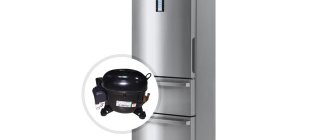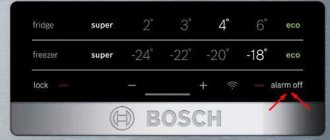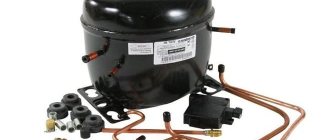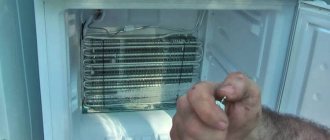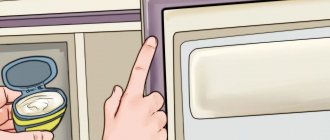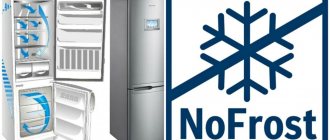Owners of old refrigerators know that over time the unit begins to freeze worse. You have to turn up the power to maximum, and eventually change the refrigerator altogether. The culprit is often a leak of freon, a gas used in the cooling system.
From this article you will find out whether the refrigerator will work without freon and how to find its leak. What to do if freon leaks from the refrigerator, and why this is possible. Does freon burn? What are the signs of its deficiency? How much does a freon cylinder cost, which one should I choose? What is the cost of repairs, if any are required? How to fill a refrigerator with freon and can it work without refrigerant? Read on for answers to all these questions.
Why does a refrigerator need freon?
Freon is a refrigerant or freezing substance with which a refrigerator cools the food stored in it. The principle of operation is as follows: freon, which is in a liquid state, enters the evaporator, where it boils and absorbs heat from the surface of the evaporator, thus cooling the chambers of the unit. Having completely boiled, freon turns into gas, which is pumped out by the compressor and sent to the condenser. There the vapors are cooled and in a liquid state are again sent to the evaporator. This process continues until the air in the chamber is cooled to the required temperature. After this, the compressor is switched off for a while. Thus, it turns out that without freon the refrigerator will not work.
The easiest and most cost-effective way to find a freon leak yourself
From all of the above, we can conclude that the easiest way to find problem areas is to use ultraviolet additives. The need to completely disassemble and then reassemble the system or purchase specialized equipment to diagnose its condition leads to an impressive expenditure of at least time, and most likely money, while pouring UV dye into the system takes a couple of minutes. By the way, if you look at thematic forums, almost all the reviews from both experts and those who personally searched for leaks will be positive, and high demand and positive assessment of the results are the best proof of the effectiveness of the method.
How to detect a leak
A freon leak, unlike many other breakdowns, has a number of characteristic signs that cannot be ignored. If at least a few of them make themselves felt, it’s worth calling a specialist. The sooner repairs are made, the cheaper it will cost.
Main signs of a leak:
- if there is too little freon in the system, the refrigerator begins to freeze worse;
- the compressor works continuously, trying to balance the insufficient cooling with constant work; under normal conditions it should take breaks every 10-15 minutes;
- one of the common causes of breakdown is when the owner of the refrigerator scrapes off an ice build-up from the freezer circuit and accidentally breaks the wall with a knife or other object (in such cases, you can hear gas whistling out of the air conditioning system);
- when the working substance is completely gone, the motor may simply not turn on;
- unpleasant odor from the compartments;
- corrosion on the door;
- the appearance of snow formations on the evaporator;
- in smart refrigerators, a message will appear on the display indicating that the temperature is above the set value;
- The refrigerator may leak.
At home, such a check can be done with a soap solution. You can prepare it yourself using dishwashing detergent (or regular soap). To do this, make a mixture that will look like water for soap bubbles. The resulting solution is applied to a sponge, and then the area where the leak is expected is thoroughly wiped. If the pipe is truly damaged, the solution will begin to bubble. You can process the entire pipe in a similar way if the location of the fault is unknown, but it will take much more time.
Refrigerator repair professionals use the following methods to find leaks:
- high pressure testing;
- immersion in water;
- adding ultraviolet composition to the main working solution;
- ultrasonic leak detector check.
Where is the highest probability of leaks?
Refilling equipment with freon is not that difficult. But to carry out repairs, it is necessary to correctly determine the location of the leak. To quickly determine the presence of cracks, it is important to know the problem areas in the equipment:
- Pipe soldering areas. The internal contour consists of elements that are joined by soldering. During the production process, joints may be welded poorly. As a result, small cracks appear at the joints, through which coolant slowly flows out.
- An evaporator that is placed inside the equipment. It is made from thin metal. When leaks appear, a layer of frost appears on the surface of the device. After removing it, you can fix the problem. A crack is difficult to repair if it is on the inside.
- Freon circulates in the heating circuit. Gas flows inside the system from the internal chambers and to the compressor. As a result, excess heat is removed. This device is used to eliminate condensation, so corrosion may occur.
Once the leak is detected, the problem can be fixed. If you have the skills, the problem can be fixed on your own. But in order for the work to be done efficiently, it is worth contacting a specialist.
The dangers of freon and its varieties
Freon is a mixture of ethane and methane, gases that are explosive and harmful to health, but the amount of them in the refrigerator is not enough to cause any harm to the body or property. This is also related to how difficult it is to determine a leak: to reduce the cost of the process, no odorous substances are added to freon (unlike, say, household gas). If any concerns still remain, you can look for the properties of a specific type of refrigerant used in the freezer in the technical data sheet or on the device itself.
The most common at the moment is freon R 134a. It is completely safe for health and non-flammable. It is not as efficient in operating properties as its predecessor, R12, but refrigeration equipment manufacturers have agreed to switch to a gas that is safer for the atmosphere and does not have such a strong impact on the ozone layer.
R 600a is theoretically explosive, the required minimum dosage is 400 grams per 15 cubic meters (average kitchen volume), in practice this means that from two to four refrigerators should be located in a completely sealed room. R 600 is the most harmless of the existing types of freon; it does not harm the ozone layer, since it occurs in nature, and is also the most effective refrigerant used in refrigerators.
R 12 is toxic and causes suffocation, but this requires that it fills 30% of the total chemical composition of the air or heats up to a temperature of over 330 Celsius. This, of course, is impossible at home. The gas is old and greatly affects the wear resistance of parts; when used, the life of the refrigerator is noticeably reduced.
Leak detectors – specialized tools for professionals
A halide leak detector, which is advisable to use only if there is chlorine in the refrigerant, is rather an industrial installation, and despite the fact that it is inexpensive, its purchase is unlikely to pay off. The use of such a device allows you to determine a leak even if it is no more than 150 grams/year, but it is still less effective than its electronic counterpart and during its use maximum care is required so as not to be exposed to dangerous vapors and open flames, discoloration, which indicates the presence of a leak.
Electronic leak detectors also work only with certain types of refrigerant, and are most often used in conjunction with other methods - testing with a soap solution or nitrogen pressure testing. Such devices are more accurate (they detect damage resulting from leakage of up to 3 grams/year), but are expensive, especially considering their short service life. There are also leak detectors that determine the location where the seal has been lost using ultrasound scanning, but they are even more expensive than the other two types of equipment, they also show better results when interacting with nitrogen and require silence during testing.
Refueling at home
The cost of repairs for such a breakdown greatly depends on the model of the refrigerator, the type of fault and ranges from two to twelve thousand rubles. So, repairing an Atlant refrigerator will cost from three to six thousand rubles, and the Indesit brand is already much more expensive - from five to twelve thousand. The cost of a cylinder with freon is similar to these amounts, or even higher - it can reach up to fifteen thousand rubles. Gas is sold in volumes that significantly exceed what is needed to fill one refrigerator. However, if you still managed to find exactly as much as required, and also if the necessary equipment was at hand, then refueling yourself can help you save a lot on fixing the breakdown. The algorithm is like this:
- A Schrader valve must be connected to the main compressor pipe. Using a regular car nipple will not give the desired effect, because the “Shredder” works in both directions at once, allowing you to create both a vacuum and increased pressure in the system;
- After this, you need to pressure test the system using a compressor pump. If the tubes are made of copper, then twenty-five atmospheres will need to be pumped into them. If aluminum, then fifteen is enough. If the pressure does not remain at the same level, it means that the pipe is not sealed and there is damage somewhere. Having found it using a leak detector, it is necessary to solder the gap and perform pressure testing again;
- at the next stage, the system is purged with nitrogen to remove moisture;
- the filter drier is replaced;
- air and nitrogen are completely pumped out;
- freon is pumped in;
- a hermetically sealed seal completes the process.
Freon leakage is a common phenomenon, often associated with the fact that the refrigeration unit gradually outlives its allotted life. Freon is safe for health and cannot burn. Its release into the air does not threaten the owners of the breakdown with anything other than a slightly increased electricity bill, however, timely repair will extend the life of the refrigerator and avoid the purchase of a new device.
Video: how to refill the refrigerator yourself
How to FILL YOUR REFRIGERATOR WITH FREON (refrigerant) yourself
Watch this video on YouTube
Video: refilling a household refrigerator
Refilling a household refrigerator
Watch this video on YouTube
Do you want to understand better than others?
- Freon leak in the Indesit refrigerator - How to understand that a leak has occurred The following signs may indicate a freon leak: The refrigerator does not cool well. If the release of freon has begun, at the first stage...
- Repairing a freon leak in an Atlant refrigerator - Repairing a freon leak in an accessible part of an Atlant refrigerator. Finding the location of damage to the cooling system. First of all, the arriving specialist must visually inspect…
- How much freon is in an Indesit refrigerator? — Definition of freon In general, freons are a fairly large group of substances that are derivatives of saturated hydrocarbons and are used as refrigerants. To them…
- What you need to know about freon in refrigerators? — Modern life is difficult to imagine without such kitchen equipment as a refrigerator. It is necessary for cooling and storing ready-made meat and fish dishes, soups, vegetables and…
- Why is my Indesit refrigerator leaking? How to find and eliminate the causes of leaks - Causes of water in refrigerators A common reason why water accumulates in the refrigerator under plastic vegetable boxes is a clogged drain hole or...
Refrigerator device
The structure and operating principle of the refrigerator is easy to understand. In nature, the principle of balance is natural; any waste of energy is necessarily compensated.
Freon is used for normal functioning of the refrigerator. Freon is a colorless inert gas consisting of methane or ethane with any substituted halogen atom. Depending on the replacement of the halogen atom, freons are classified into different markings (for example, R-41, R-32, etc.).
Freon is a refrigerant that easily passes from one state of aggregation to another. As a result, freon absorbs warm energy from the freezer and evaporates it into the air.
Ultraviolet dye method
This technique is mainly used for automobile air conditioners.
The general essence of this technique is quite simple:
- A special dye is pumped into the system, which is tested.
- After some time, paint appears at the leak site, where it is detected using an ultraviolet lamp
The main disadvantage of this option is the need to wait for the result.
Typically, this option is used when others are not effective.
The second drawback is that the dye is not cheap and requires the purchase of other additional equipment - an ultraviolet lamp and special glasses.
Checking the system under pressure
The essence of the method is as follows:
- The pressure in the system increases. But no more than those values indicated on the equipment or in the technical passport for it.
- Pressure and temperature indicators are recorded.
- After some time, the pressure level is checked - if it is reduced, then there is a leak in the equipment.
This option is used both for large systems with long routes, for example VRF systems, and for any others.
Typically, for copper lines and external blocks, the pressure test is 41.5 Atm., for internal blocks made of aluminum 21.5 Atm., unless a different value is indicated in the passport.
With large leaks, they can be heard audibly - hissing.
For small ones, you can use other methods together - soap suds or add freon along with nitrogen (or not bleed off the residue initially) and use an electronic leak detector.
In this case, the efficiency will increase significantly, since the amount of incoming gas at high pressure will be much greater.
Equipment for nitrogen pressure testing
For large industrial systems, 40 liter cylinders with dried nitrogen are used.
Service technicians and installers use 10 liter cylinders, which are easy to transport in passenger cars; for household and semi-industrial systems, 1-2 such cylinders are enough.
To regulate the pressure level, you need a reducer with a maximum pressure of more than 50 Atmospheres.
It has two pressure gauges - for measuring the pressure in the cylinder and at the outlet after the reducer.
When choosing a gearbox, you must be careful, because even if the pressure gauge scale has a limit value of 50 Atm. this does not mean that the reducer is designed for this pressure.
Each reducer has an emergency release valve that will prevent the outlet pressure from rising above the rated level.
The most affordable reducer for these purposes is the oxygen RK-70 with a maximum pressure of 70 atm.
Where to top up the system
Refilling with freon is a simple procedure, but attempts to do it yourself are rarely successful. It is necessary not only to fill the cooling system with refrigerant, but also to eliminate the cause of the leak, and in some cases, to repair components damaged due to a lack of working substance. If you have discovered a freon leak and want your refrigerator to be repaired by a professional, contact the 24Master service An experienced specialist will select the required brand of refrigerant (it is usually indicated on the compressor).
Why is the volume of gas decreasing?
Leakage is divided into two types:
- In accessible places (compressor, condenser, filter, evaporator with No Frost system). Nowadays, the most economical evaporators with thin tubes are increasingly being manufactured. They are subject to corrosion. And as you know, if rust appears in one place, wait in another.
- In inaccessible places. There, aluminum tubes rust due to contact with copper and water. Condensation exists, although thermal insulation is provided.
In addition, leakage is a very slow process that can last a year.
Problems with the refrigerator
System problems can be recognized by significant signs:
- The unit is overheating.
- The heat exchanger does not have the properties due to which the walls should freeze.
- Temperatures in freezers and refrigerators are rising.
- The bellows fitting near the heat exchanger is poorly cooled.
- The condenser's pressure decreases.
- The heat intake is not intense.
- There is an increase in the compressor's power level.
- As a result, the evaporator and condenser begin to operate at elevated temperatures.
Signs of a freon leak, as you can see, can be found in many different ways. It's better to trust the specialists. They will detect and fix the problem using special equipment. Visually, it is not recognizable in any way, because the refrigerant does not smell or have any color.
Signs of a freon leak
It can flow from microcracks or from the joints of connecting tubes. This problem should not be neglected, because the refrigerator compressor may break. Which will entail expensive repairs. Or even worse, you will have to change your equipment.
Is freon dangerous for health?
Freons are a group of saturated fluorinated hydrocarbons that are used in home and industrial refrigeration equipment. There are 16 species. The refrigerant is produced in the form of a volatile liquid or an inert gas, and it is usually designated by the letter R and a digital code indicating the number of carbon, hydrogen and fluorine atoms.
The question of whether freon is harmful to humans can be answered this way: in reality, no, but in theory, yes. However, people often exaggerate the danger of its leakage, which is quite possible if the refrigerator breaks down. Let's dispel the myth: refrigerants used in home equipment do not burn and are completely harmless to health. It is impossible to determine a freon leak by smell - since the substance is non-toxic, no flavorings are added to it, like household gas. Only the family budget will feel the problem: a lack of refrigerant will lead to an increase in the temperature in the refrigerator chambers, which means that food will spoil ahead of schedule.
The only dangerous type of freon is R-22; a chemical warfare agent is obtained from it, which becomes toxic at temperatures above +400 °C. However, today this freon is prohibited for the production of home appliances, so it is impossible to encounter it in everyday conditions. Refrigerant only really poses a health hazard if the leak is from a large cooling unit.
Using an Electronic Leak Detector
Such equipment is considered the most effective option for detecting refrigerant leaks. Usually, its result is additionally checked by another method - applying a soap solution in order to accurately determine the location of the leak.
It is important to remember that the use of an electronic leak detector is only possible with equipment that operates on the type of freon for which the leak detector is intended.
When operating this product, it is necessary to exclude the presence of carbon monoxide and alcohol vapor in the ambient air, as they significantly reduce the level of sensitivity of the equipment used.
The capabilities of this option make it possible to detect very small leaks of 3-5 g/year.
Electronic leak detectors have an adjustment to reduce or increase sensitivity - for the smallest leaks it should be set to maximum.
Also very convenient is the “Reset sensitivity to background level” function, that is, if there is a certain concentration of freon in the ambient air, and the leak detector reacts to it even at the lowest sensitivity, then you can reset it.
After this, this concentration will be considered zero for it and the device will not respond to it.
To increase the efficiency of leak detection, you can also increase the pressure in the system with dry nitrogen.
Disadvantages of electronic leak detectors
- It is impossible to find a leak outdoors in windy weather
- Sensors need to be changed periodically
- High cost of the device
Recently, Chinese leak detectors have appeared, which are not so expensive, but no less effective than their branded counterparts from CPS or Inficon.


